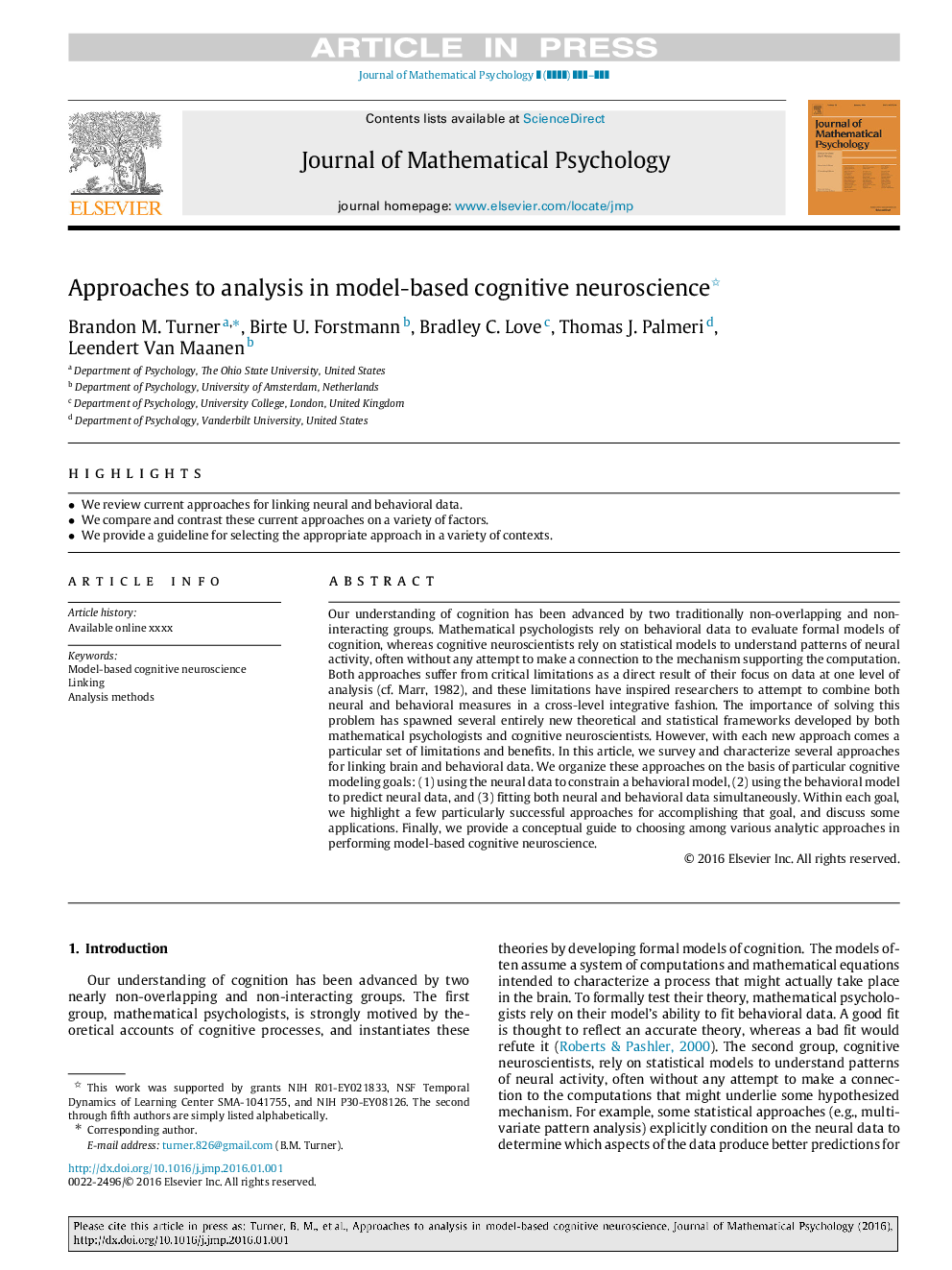| کد مقاله | کد نشریه | سال انتشار | مقاله انگلیسی | نسخه تمام متن |
|---|---|---|---|---|
| 4931865 | 1363397 | 2017 | 15 صفحه PDF | دانلود رایگان |
عنوان انگلیسی مقاله ISI
Approaches to analysis in model-based cognitive neuroscience
ترجمه فارسی عنوان
رویکردهای تحلیلی در علوم اعصاب شناختی مبتنی بر مدل
دانلود مقاله + سفارش ترجمه
دانلود مقاله ISI انگلیسی
رایگان برای ایرانیان
کلمات کلیدی
عصبشناسی شناختی مبتنی بر مدل، ربط دادن، روش های تجزیه و تحلیل،
ترجمه چکیده
درک ما از شناخت، توسط دو گروه سنتی غیر همپوشانی و غیر تعاملی پیشرفت کرده است. روانشناسان ریاضی بر مدل داده های رفتاری برای ارزیابی مدل های رسمی شناخت تکیه می کنند در حالیکه دانشمندان علوم اعصاب شناختی به مدل های آماری برای درک الگوهای فعالیت عصبی وابسته هستند، اغلب بدون هیچ گونه تلاش برای اتصال به مکانیسم حمایت از محاسبات. هر دو روش از محدودیت های بحرانی به عنوان یک نتیجه مستقیم از تمرکز خود بر داده ها در یک سطح از تجزیه و تحلیل (مارس، 1982) رنج می برند، و این محدودیت ها محققان را به تلاش برای ترکیب اقدامات عصبی و رفتاری در یک حالت انتگرال متقابل . اهمیت حل این مشکل، چندین سیستم کاملا نظری و آماری جدید ایجاد شده توسط روانشناسان ریاضی و دانشمندان علوم اعصاب شناختی ایجاد شده است. با این حال، با هر رویکرد جدید مجموعه ای از محدودیت ها و منافع است. در این مقاله، چندین رویکرد برای ارتباط مغز و داده های رفتاری را بررسی و توصیف می کنیم. ما این رویکردها را بر اساس اهداف مدل سازی خاص شناختی سازماندهی می کنیم: (1) استفاده از داده های عصبی برای محدود کردن یک مدل رفتاری، (2) استفاده از مدل رفتاری برای پیش بینی داده های عصبی، و (3) هماهنگ سازی داده های عصبی و رفتاری همزمان. در هر هدف، ما چندین روش بسیار موفق برای انجام این هدف را برجسته می کنیم و برخی از برنامه ها را مورد بحث قرار می دهیم. در نهایت، ما یک راهنمای مفهومی برای انتخاب در میان روش های تحلیلی مختلف در انجام علوم اعصاب شناختی مبتنی بر مدل ارائه می دهیم.
موضوعات مرتبط
مهندسی و علوم پایه
ریاضیات
ریاضیات کاربردی
چکیده انگلیسی
Our understanding of cognition has been advanced by two traditionally non-overlapping and non-interacting groups. Mathematical psychologists rely on behavioral data to evaluate formal models of cognition, whereas cognitive neuroscientists rely on statistical models to understand patterns of neural activity, often without any attempt to make a connection to the mechanism supporting the computation. Both approaches suffer from critical limitations as a direct result of their focus on data at one level of analysis (cf. Marr, 1982), and these limitations have inspired researchers to attempt to combine both neural and behavioral measures in a cross-level integrative fashion. The importance of solving this problem has spawned several entirely new theoretical and statistical frameworks developed by both mathematical psychologists and cognitive neuroscientists. However, with each new approach comes a particular set of limitations and benefits. In this article, we survey and characterize several approaches for linking brain and behavioral data. We organize these approaches on the basis of particular cognitive modeling goals: (1) using the neural data to constrain a behavioral model, (2) using the behavioral model to predict neural data, and (3) fitting both neural and behavioral data simultaneously. Within each goal, we highlight a few particularly successful approaches for accomplishing that goal, and discuss some applications. Finally, we provide a conceptual guide to choosing among various analytic approaches in performing model-based cognitive neuroscience.
ناشر
Database: Elsevier - ScienceDirect (ساینس دایرکت)
Journal: Journal of Mathematical Psychology - Volume 76, Part B, February 2017, Pages 65-79
Journal: Journal of Mathematical Psychology - Volume 76, Part B, February 2017, Pages 65-79
نویسندگان
Brandon M. Turner, Birte U. Forstmann, Bradley C. Love, Thomas J. Palmeri, Leendert Van Maanen,
